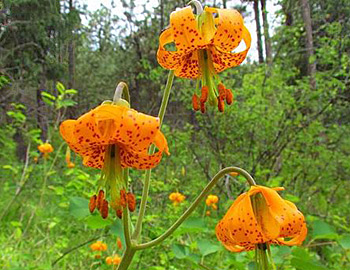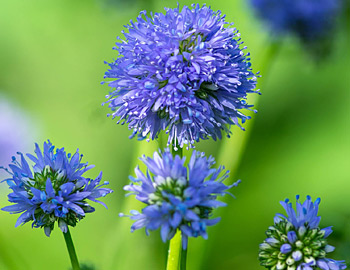PLANTING NATIVE SEEDS
Growing WHERE you are planted… successful native seed planting
Native plants are stubbornly successful in their element, nature. When landscapes match conditions where natives are customarily found in nature you will succeed with time. Remember that in natural settings almost all seeds are lost due
to survival conditions being too challenging. The few individuals that survive represent a continuation of the plant species and natives seldom overrun an area where they grow. A metaphor for native seed survival is like baby turtles who run the gauntlet
to the sea and then to maturity and survival of the individual and the species overall. Not too many make it to reproduction but in the process we can surely enjoy the ones that do. And so it is with planting native seeds however, when landscapers replicate nature to
their best ability it still can seem that we have lost most of the results of our efforts unless we really get it right. Many natives require several years of favorable conditions to produce flowers for the world. Be prepared to wait it out for these species unless
you have chosen an annual that likes to show off and reproduce by itself and “grow where they are planted.” Planting seeds is satisfying because you are covering all the bases from seed to flowering. Realistic expectations, patience, site preparation and maintenance, seasonal timing, and
putting the right plant in the right place are the ingredients for success.
Seasonal timing: WHEN do you want to plant your seeds … in Fall, Winter, or Spring?
In natural settings seeds fall to the ground when mature or travel with the wind or on some animal until they reach the earth somewhere, hopefully in a good location to survive and thrive. Following mother nature’s schedule is a sure winner so, know your species.
Fall Planting
Some annuals and perennials need to have a cold period to convert from a seed into a rooting, growing, and flowering plant. This is ‘cold stratification’. Your soil needs to be cool in the fall so your seeds do not sprout prematurely and get frozen out prematurely. 55 degrees is a benchmark
for seeding in the fall to prevent your plants from getting “frothy” with too much early growth to withstand the cold weather ahead. Interestingly enough, some species like to get established in the fall before going into winter to be able to reproduce. This is ‘vernalization’, the ability
to flower after prolonged exposure to low soil temperatures, as during the winter in a temperate climate. Western Oregon is a temperate climate having wider temperature ranges throughout the year and more distinct seasonal changes compared to tropical climates and with distinct seasons, plants
wait for vernalization to know that they must wait until it is again warm enough to safely grow again without winter damage. Plants dry out too much during freezing weather and also ‘heave’ out of the soil by following ice crystals as they rise to the surface of soil during
freeze-thaw episodes. Vernalization is a mechanism that plants use to adapt to their natural surroundings and climates so that they do not sprout too soon for successful growing conditions going into the next sequence of seasons.
Winter Planting
This may be best done onto or during snowfall. The snow itself can make an igloo effect and at the same time prepare the seed for accepting the spring growing conditions that give your seeds a jump-start on weeds and any existing vegetation that may be there already. Nature always
fills a void. Have you ever seen a place where plants do not fill an open space, given the right conditions for plants to grow?
Spring planting
Seeds need to have enough moisture going into summer for their roots to follow the moisture down into your soil profile as the season progresses. Seed most species by mid-February to accomplish this when we get that late-winter, early spring opportunity.
HOW To Plant Wildflowers
Choose a spot on your property that receives at least 6 hours of sun per day unless your species is a shade-loving species. The more sun, the better with most natives. Your do not want to see your new plants bending to reach a sunnier place. They will
need either steady sun or a blend of light and shade.
Prepare the planting site soil by removing existing growth and loosen your soil to have enough air to breath and for the roots to grow. Some will only need to be dropped onto pea-gravel but still, they need to be able to penetrate the earth and be protected.
Mix your seed with sand to provide more even distribution of the seed and for better visibility. Mix 8-10 parts sand to 1 part seed for even coverage. You may wish to seed half of the mix in one direction and then half in the other direction for a more even
distribution. I have also used granular dolomite where the soil is nutrient-challenged. It releases nutrients in clay soil and loosens it up. If you're planting a larger area, use either a spin-spreader or a drop-spreader. If it's a smaller area, just spread your admixture by hand. It is rewarding
to feel things as they happen from you own hand.
In order for seed to then make optimum contact with the soil carefully compress or very lightly cover your seed to no more than the diameter of the seed itself. To allow the seeds full sunlight, I usually do not cover them in any way. The better seed-to-soil contact, the better
chance of germination. A flex-rake can make it happen as well by just stirring seed and soil on top a little like salt and pepper on eggs.
By planting early enough there may be enough water through the growing season to allow seeds to follow soil moisture down and through the growing season but, as things may generally get warmer be prepared for a follow-up watering of two to replicate natural spring rains
as needed. You may notice that after a rain or watering, soil shows moisture in the morning and when that no longer is the case just dig down until you find moisture and when needed, then add more water.
Annual species bloom the year that you seed them if conditions are good. Perennial species will not do any blooming until 2-3 years of growth and vernalization. Fertility, moisture, and organic matter levels must be carefully guided for many perennials to survive
as climate tends to be warmer and drier overall. That said, natives have survived for many millennia without our help. If you are making a native meadow, just be patient for a few years and use the right percentage of each species to match nature in its’ many expressions.




